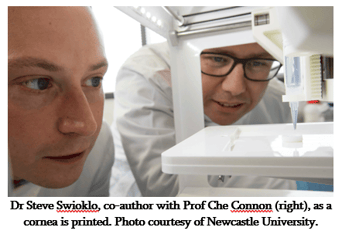
With little fanfare in the media, researchers announced that they had successfully used 3D printing to produce the first human corneas for transplant.
In a report in the journal Experimental Eye, the research team led by Abigail Isaacson at the Institute of Genetic Medicine, Newcastle University, UK demonstrated the use of collagen-based bio-ink containing encapsulated corneal keratocytes, the primary cells that form the cornea, to produce a cornea that could be transplanted into a human eye. The study was a proof of concept trial and did not actually use the printed cornea for transplantation.
The cornea is the outermost layer of the eye and plays a key role in focus. Worldwide there are 10 million people requiring surgery to prevent corneal blindness as the result of diseases or infections. Consequently, there is a significant shortage of human corneas for transplant.
The objective of the experiment was to determine if human stem cells, called human corneal stromal cells, could be combined with a collagen solution to make a bio-ink that could be used in a 3D printer to produce a transplantable cornea.
Using a simple, low-cost 3D bio-printer, the researchers showed that the bio-ink was successfully extruded in concentric circles to form a human cornea. The printing time was less than 10 minutes. Once built, the stem cells were then shown to grow, demonstrating that the cells remained viable after the printing process.
"Our unique gel – a combination of alginate and collagen – keeps the stem cells alive whilst producing a material which is stiff enough to hold its shape but soft enough to be squeezed out the nozzle of a 3D printer,” said Che Connon, Professor of Tissue Engineering at Newcastle University in a press release.
"This builds upon our previous work in which we kept cells alive for weeks at room temperature within a similar hydrogel. Now we have a ready-to-use bio-ink containing stem cells allowing users to start printing tissues without having to worry about growing the cells separately."
In addition to demonstrating a viable printed cornea, the researchers also showed that they could build a cornea to unique patient specifications by scanning the patient’s eye and using the data to rapidly print a cornea that matched the patient’s eye size and shape.
While additional testing will be needed before clinical trials can be undertaken, the advance moved the research one step closer to one day being able to offer non-donor corneal transplants, which could have a significant impact on patients with sight loss.
Kapstone Medical is a full-service product realization firm that partners with inventors and manufacturers of all sizes to rapidly develop and commercialize new medical devices or processes. We love sharing the latest news in 3D printing and what’s going on in the MedTech Industry.
Source: Newcastle University Press Office: First 3D printed human corneas



